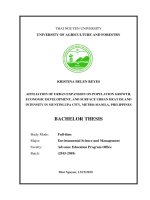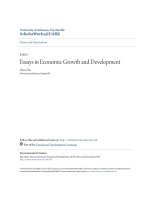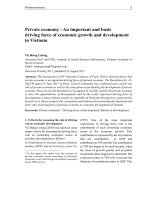Economic growth and economic development 703
Bạn đang xem bản rút gọn của tài liệu. Xem và tải ngay bản đầy đủ của tài liệu tại đây (103.04 KB, 1 trang )
Introduction to Modern Economic Growth
substitution between capital and labor greater than 1 would imply that production
is possible without labor or without capital, which appears counterintuitive.
Now, recall that when σ < 1, factor-augmenting and factor-biased technologies are reversed. Therefore, labor-augmenting technological change corresponds
to capital-biased technological change. Then the question becomes: under what
circumstances would the economy generate relatively capital-biased technological
change? And also, when will the equilibrium technology be sufficiently capital biased that it corresponds to Harrod-neutral technological change? The answer to
the first question is straightforward. What distinguishes capital from labor is the
fact that it accumulates. In other words, the neoclassical growth model, with some
type of technological change, experiences continuous capital-deepening as K (t) /L
increases. This, combined with Proposition 15.3, immediately implies that technological change should be more labor-augmenting than capital augmenting. We
summarize this result in the next proposition, treating the increase in K (t) /L as a
one-time increase and thus looking at the comparative statics of the BGP equilibrium (full equilibrium dynamics are investigated in the next two propositions).
Proposition 15.12. In the baseline model of directed technological change with
H (t) = K (t) as capital, if K (t) /L is increasing over time and σ < 1, then
NK (t) /NL (t) will also increase over time as well.
Proof. Equation (15.37) and σ < 1 imply that an increase in K (t) /L will raise
Ô
NK (t) /NL (t).
This result already gives us important economic insights. The reasoning of directed technological change indicates that there are natural reasons for technology to
be more labor augmenting than capital augmenting. While this is encouraging, the
next proposition shows that the results are not easy to reconcile with purely-labor
augmenting technological change. To state this result in the simplest possible way
and to facilitate the analysis in the rest of this section, let us simplify the analysis
and suppose that capital accumulates at an exogenous rate, i.e.,
(15.46)
K˙ (t)
= sK > 0.
K (t)
689









